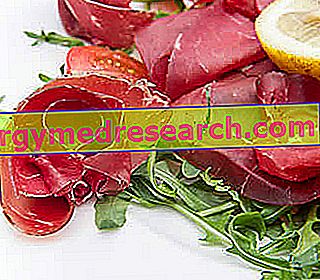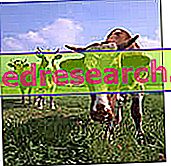Bresaola and Pregnancy
Bresaola
Bresaola is a typical sliced meat from northern Italy. The most famous is native of Valtellina (province of Sondrio, Lombardy) and enjoys the recognition of Protected Geographical Indication (PGI).

The bresaola is obtained from the processing of some muscles positioned in the hind limbs of the beef or horse (topside, shank, magatello and under the skin). The meat, after being trimmed, salted and left to rest (about 15 days), is stuffed and seasoned (at least 30 days). It is therefore a preserved meat that falls within the fundamental group of foods.
In the kitchen it is used especially raw for appetizer and food recipes, but there are also recipes that require it to be cooked quickly in a pan (especially in sauces for pasta dishes).
Pregnancy
Pregnancy or gestation is the special physiological process during which the fruit of conception develops in preparation for birth.
Also known as an interesting state, it represents a period that is about 9 months long and very delicate, during which the mother is required to satisfy all the needs of the unborn child. Among these, the nutritional supply is of great importance because, without the elements necessary for development, the embryo / fetus is likely to suffer serious deficiencies that increase the risk of pathologies, malformations or abortion. There are also many risks related to overeating and consequent obesity and / or metabolic pathologies. As if this were not enough, the child may be particularly prone to complications due to: poisoning (bacterial toxins, fungal toxins, pollutants), infections (viruses, bacteria) and infestations (parasites).
To assess whether bresaola can be a suitable food or not for pregnancy, it is necessary to carefully evaluate its usefulness in the diet of the pregnant woman and any related risks.
Nutritional Utility
Function of bresaola in pregnancy
As we have anticipated, bresaola is a product that belongs to the fundamental group of foods. It is an abundant nutritional source of:
- High biological value proteins
- Useful minerals (iron, zinc, potassium, phosphorus)
- Useful vitamins (B1, PP, B12 etc).
Bresaola has a low intake of fat and calories, and does not contain lactose or gluten; these characteristics make it suitable for most diets.
For a NORMAL subject (excluding for a moment the gestation), the average portion of bresaola would be equal to 50 g (about 150 kcal) and the maximum frequency of consumption of 1-2 times a week.
All nutritional requirements increase during pregnancy; for reasons closely related to the composition of foods and their frequency of consumption, those most often subject to deficiency are: folic acid, iron, vitamin B12, vitamin D and omega 3 essential fatty acids.
Bresaola contributes to providing interesting quantities of both highly bioavailable (emic) iron and cobalamin (vit B12), and all in all it does not provide excessive levels of saturated fat, cholesterol and total calories. It would therefore seem a perfect food for pregnancy but, as we will see, unfortunately it is not.
Risks and Dangers
Bresaola and gravidic hypertension
Because of the salting, as is the case with other meats, bresaola is very rich in sodium. This mineral, if present in excess in the diet, can harm the health of sodium-sensitive individuals, encouraging the onset or aggravation of primary arterial hypertension.
The so-called gestational hypertension, which occurs more easily from the third trimester, can worsen the well-being of both the fetus and the mother. It therefore becomes necessary to keep it monitored, ensuring that it does not exceed the threshold of 90 mmHg and 140 mmHg (minimum and maximum); in case of increase (or previous hypertension), the intake of any salty food such as bresaola is to be suspended completely (or avoided from the beginning).
Bresaola, nitrites / nitrates and pregnancy-induced diabetes
Commercial bresaola is added with sodium / potassium nitrites or nitrates and ascorbic acid (vitamin C), useful to increase its conservation; on the other hand, the effect of these preservatives is limited to hindering oxidation and bacterial proliferation, while they are ineffective against parasites. Furthermore, we remind you that nitrates and nitrites (identifiable with the abbreviations E249-E250 and E251-E252 mentioned on the label) increase the risk of nitrosamine formation. In turn, these undesirable compounds are certainly implicated in the formation of various cancers, such as that of the stomach, but during pregnancy they assume a different negative role. Some experimental investigations have in fact correlated the abundance of nitrosamines in the diet with the increased risk of pregnancy-induced diabetes, a metabolic pathology of the mother that can induce fetal malformations and therefore absolutely to be avoided. The cause could be the autoimmune stimulus by nitrosamines of the immune units against pancreatic beta cells in the pancreas.
Bresaola and parasitosis
The pathology of a parasitic nature that, in general, most scares future mothers is toxoplasmosis (from Toxoplasma godii ). It is an infestation quite dangerous for the fetus, but harmless to the expectant mother. Once contracted, it can cause neonatal malformations or fetal death.
Let us remember that, although contracted, it is not however said that toxoplasmosis exerts these frightening effects. Moreover, in the first stage of gestation there is less chance that the mother will pass to the child by crossing the placenta, but the damage can be severe. On the contrary, in the last period there are more chances for it to happen, but the damage should be less. However, beef and horse are not animals that typically contain toxoplasma inside muscle fibers, so bresaola should not be an effective vehicle for this parasite.
Bresaola is also free from the risk of contracting the solitary worm (from Tenia solium ), which affects almost exclusively pork; hence the name of swine tapeworm. The same goes for trichinellosis (Trichinella).
Cattle, on the other hand, can be carriers of Cryptosporidium parvum (a pathogen of cryptosporidiosis), which however only colonizes the intestine. Rarely this pathology, even if it is spread by fecal gold, affects humans through food.
Bresaola is therefore not a particularly dangerous food from the point of view of pests, but the general recommendation to avoid raw meat remains. However, if you still want to eat a few slices of bresaola at "zero risk", you can still skip them quickly.



